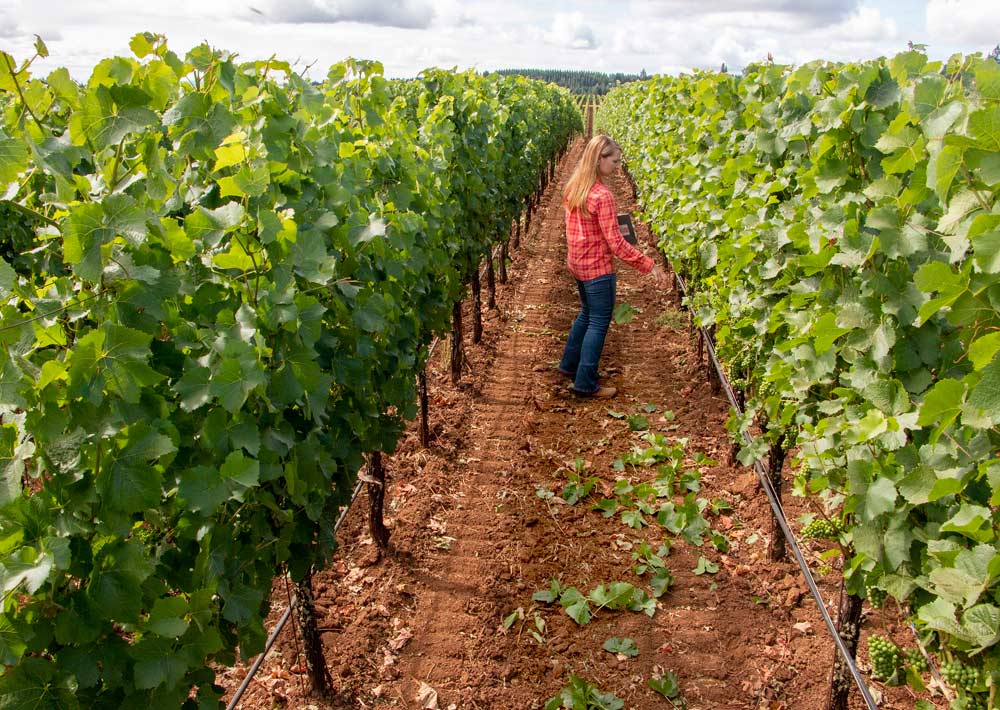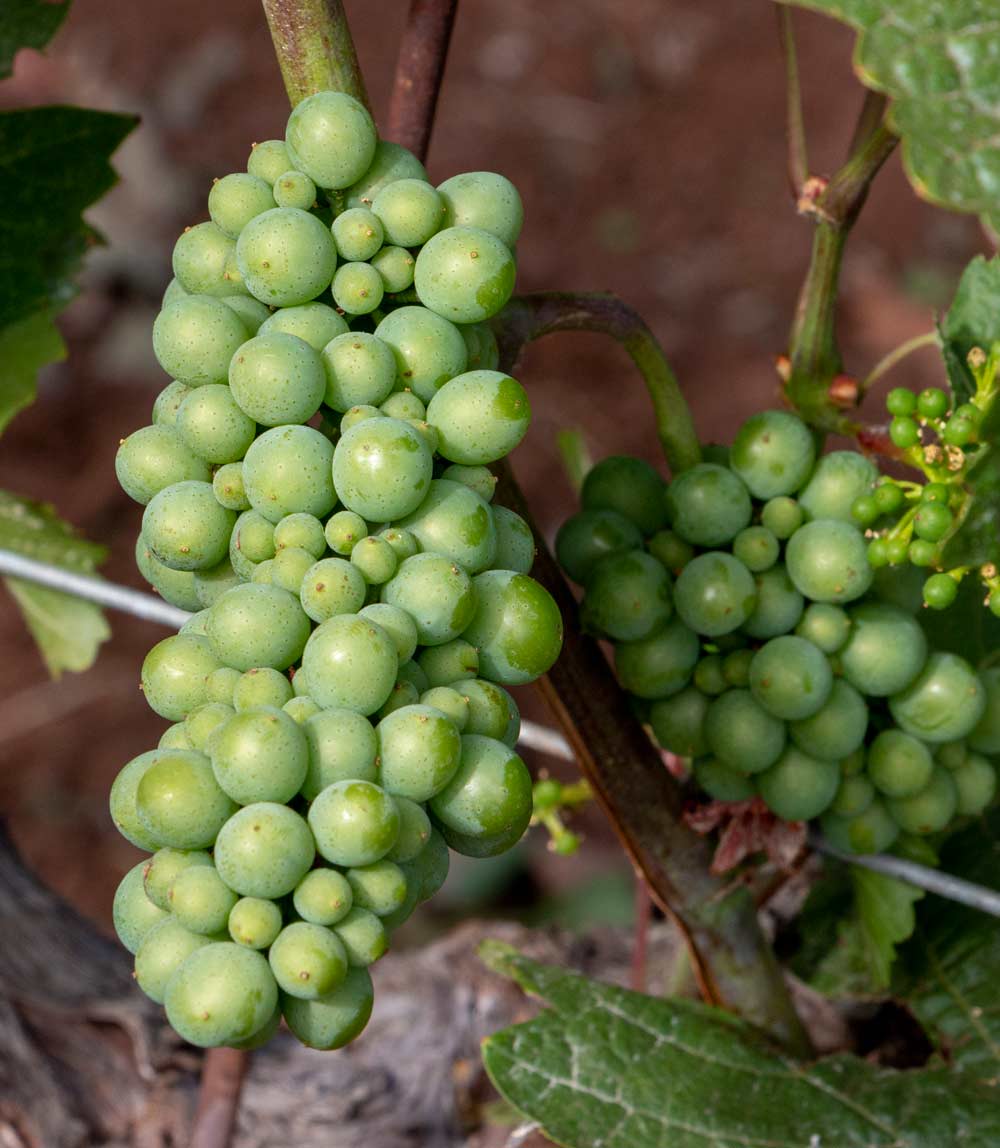
When researcher Patty Skinkis arrived at Oregon State University in 2007, wine grape growers were focused on one key factor — yield — when it came to managing the quality of their signature variety, Pinot Noir. Each year, they held the crop to no more than 2 to 2.5 tons per acre, saying that the cool climate just did not allow them to harvest more.
Skinkis believed their crop levels could be higher — significantly higher. And she set out to prove it.
Now in year seven of a 10-year project to examine Oregon’s wine grape crop yields, the results have some growers reevaluating their long-held yield-versus-quality perceptions.
“We need more research, but people have been convinced that they can increase yields without lowering quality,” said Skinkis, OSU associate professor and viticulture extension specialist. “It’s all in thinking about the capacity of a particular vineyard site.”
Skinkis started the research with small, 1-acre trials on plots in western Oregon’s Willamette Valley and in the Illinois Valley, in the southern part of the state, both planted in Pinot Noir. She found crop levels could be quite a bit higher, even after analyzing the wines and discovering they remained of high quality.
Not everyone agreed. “Nobody believed the results,” she said. “They said it was too small scale.”
So, she increased the size of the project and enticed growers and winemakers to get involved in gathering and sharing data, in the hope that they might see the results firsthand. The first year, 2012, Skinkis had 10 companies participate. In the years since, she’s averaged 12 to 15 companies each year, with more than 20 companies overall since the project’s inception. Many of the original companies remain involved today.
Joey Myers, newly hired this year as manager of viticulture for A to Z Wineworks in Newberg, Oregon, has been an adviser to the crop load project for years as an active member of the region’s tech group. “I feel like Patty’s work has basically allowed us to set some metrics for identifying the upper limits of ripening and has helped people to give a scientific approach to finding what crop level suits their sites and suits their winemaking style,” he said.
Ken Kupperman, vice president of Oregon farming for Jackson Family Wines, said the company wanted to support Skinkis’ work and learn better methods for its vineyards, but also for the wider wine community. “What we think is correct we want to verify with science,” he said. “Patty is able to crunch the numbers and then our winemakers can taste the wines and draw conclusions.”

Oregon’s Pinot Noir history
Like Washington, Oregon’s wine industry has thrived in recent years, with the number of vineyards nearly doubling to more than 1,100 since 2005 and the number of wineries now at more than 760. Small is king, though; 70 percent of those wineries produce fewer than 5,000 cases per year.
What hasn’t changed: The predominant variety planted on Oregon’s 33,000-plus acres of wine grapes remains Pinot Noir, comprising nearly 60 percent of all grapes grown there.
The heavy, French Burgundy influence in Oregon means many growers — already risk-averse in the cool growing climate — take steps to really control their yields, Myers said. “For a long time, people overdid it with the crop thinning, and that in itself is a reaction to the very early years, late ’70s and early ’80s, where people weren’t doing any thinning at all,” he said.
A healthy Pinor Noir canopy in Oregon could support 5 tons, he said. “The California metrics of pruning weight versus fruit weight, we were off the chart,” Myers said. “We have so much more brush than we have fruit, but we just don’t have the heat and the light to ripen 5 tons. So, if we have technically a 5-ton canopy but we can’t ripen it, what can we ripen?”
That’s exactly what Skinkis is trying to determine, by crunching numbers across vintages and vineyard sites and wineries at the end of the project. She’s also trying to get growers to think of yield on a pounds-per-foot basis, rather than tons per acre.
There are plenty of variables to consider, including elevation, soil type, heat units and hourly temperatures. Vine spacing, density, rootstock and cloning all play a role in the load a vine can carry and ripen effectively.
Most growers participating in the study chose two or three different crop levels, start at a half-cluster per shoot up to two clusters per shoot. One vineyard is evaluating five crop levels.
They then collect information at key phenological stages throughout the year, including fruitfulness in spring (number of flower clusters per shoot), veraison (tissue sampling for nutrient analysis, Brix, pH and titratable acidity two times before harvest) and harvest (yield weights). The OSU lab also analyzes the fruit from harvest for composition, looking at YAN (yeast assimilable nitrogen), total phenolics, total tannins and total anthocyanins, as well as Brix, pH and titratable acidity. The growers themselves also collect pruning weights during the season.
A to Z is cropping one section of a block to three different levels of thinning and following through to the chemistry evaluation of the wines. The company prefers to maintain crop levels of 2.5 tons per acre on its higher-end wines. Other sites, depending on vine spacing, naturally set 3 or 3.5 tons to the acre, depending on vine spacing and vigor, Myers said.
“These past five seasons have been unusually warm, and droughty,” he said. “So, theoretically, these higher crop loads would delay ripening a little bit, but we haven’t really seen that be the case.”
That’s true for A to Z, but also true overall according to the study results so far, Skinkis said.
Jackson Family Wines is working three replications of three treatments on 3 acres of Pinot Noir and 3 acres of Chardonnay, the latter started just this year: one cluster per shoot, a 2-1-2-1 pattern and two clusters per shoot taking off all wings.
“We feel we have a good understanding on the pounds per linear foot for Pinot Noir. I have winemakers that I highly respect that believe there is a concentration that can be tasted in Chardonnay with reduction in yields, and we want to prove that,” Kupperman said.
So far, he said, the Pinot block has actually seen growth changes, where higher yields have reduced pruning weights. “The trial is a huge investment of time, but it’s also a huge return.”
Overall, Skinkis said, she’s seen few changes to nutrient status or fruitfulness in the participating vineyards by increasing yields. “The only thing we’ve seen so far is that we’re not reaching the point of being overcropped yet,” she said.
At one site the data show a lag in ripening, or Brix levels are lower with the highest crop levels, but those issues probably could be addressed by harvesting later. Most participating sites harvest all crop levels on the same day for the research project; however, several are doing a differentiated harvest in 2018, and “they may find that they do catch up by the end of their traditional harvest season,” she said.
Oregon’s growing season is short, and growers need to know how best to leverage it. In 2011, bloom was July 11. Bloom hit June 1 in 2016. If they have an earlier bloom and a longer season, Kupperman said he believes they may be able to carry more fruit and maintain balance. “If we have a shorter season and less heat units, we need to have reduced yields and not overcrop the vines,” he said. “Bloom date sets what we can do with the season.”

What about the wines?
In some ways, Oregon’s industry has been a little bit more precious, because by farming for high-end wines, growers already manipulate crop loads to some degree and can afford it, Myers said. “The interesting shift is in the blocks where people are looking to reduce their costs in order that they can offer a better bottle price,” he said.
Skinkis and her research team have a two-pronged approach to the sensory evaluation of the wines produced from these blocks. A professional winemaker panel tastes the wines from all sites in a given vintage and provides descriptive analysis, following two years of bottle aging. In addition, in-house tastings are done by all of the producers at their individual wineries, tasting wines blind individually and then as a group.
So far, she said they have found few to zero differences in the wines from all of the sites from the 2012 to 2015 vintages that were analyzed by the professional winemakers.
As for the in-house panels, only two producers have completed those to date. “What they’re generally finding is they all make great wines,” Skinkis said. “That just goes to show you’re just tweaking, I think, in the vineyard. It makes sense you wouldn’t have terrible fruit.”
Oregon has funded the statewide cropload project from the beginning, but for 2018-19, the Napa, California-based American Vineyard Foundation is contributing $47,000 as well.
“So, obviously, California cares about cropload management in Pinot Noir, too,” Skinkis said with a smile. •
—by Shannon Dininny






Shannon, your article here about the pinot profusion in Orgeon is fantastic, and I learned a lot from reading this article. I will be sharing the contents of this article with my mates so that they can enjoy reading this.